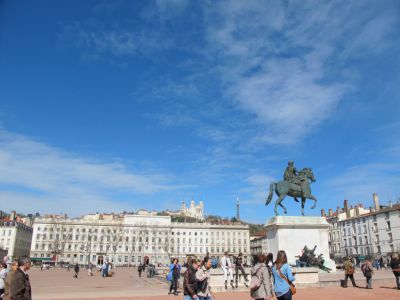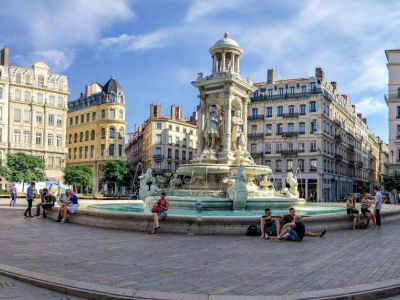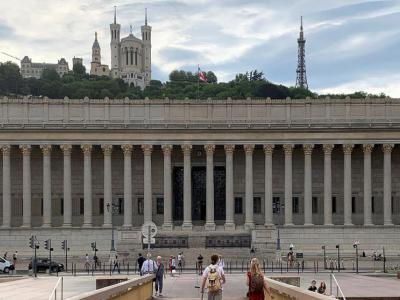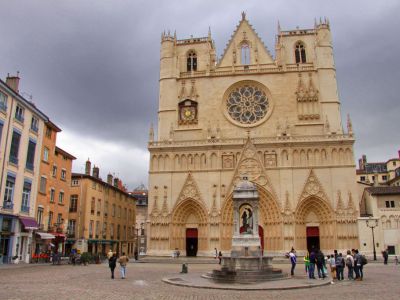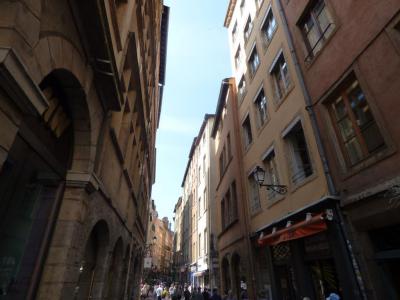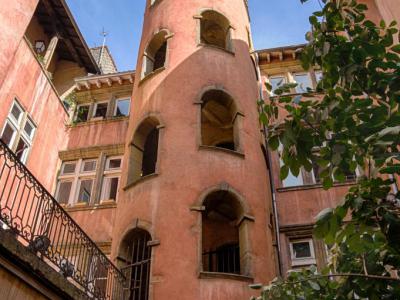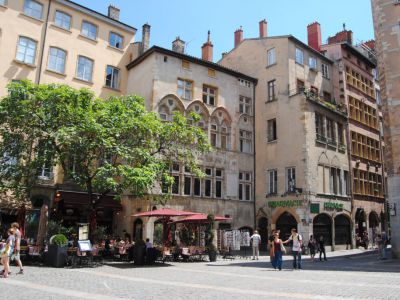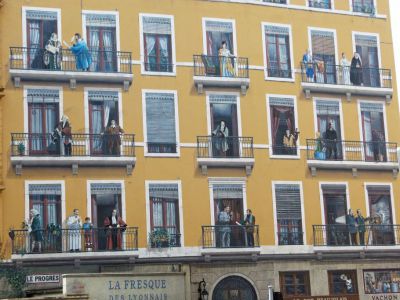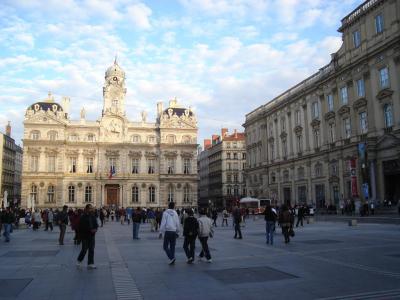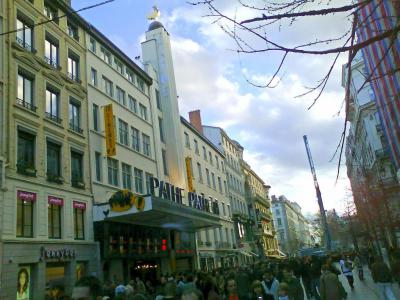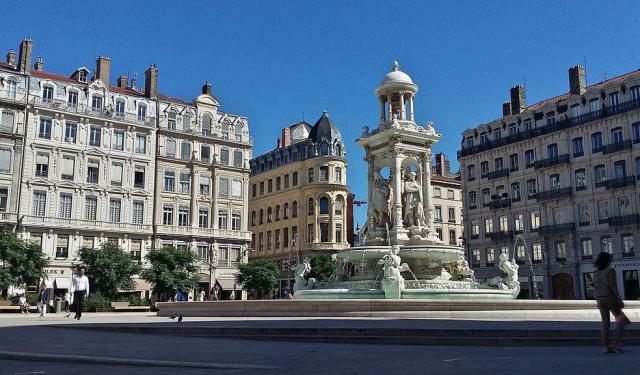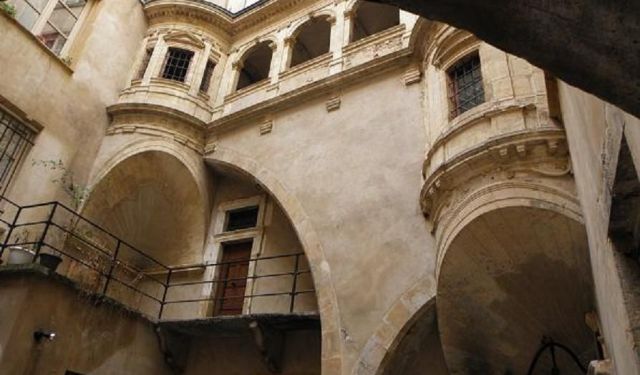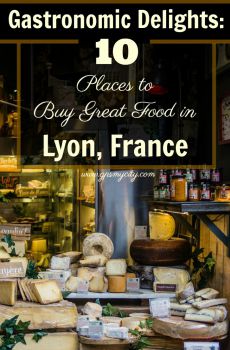Lyon Introduction Walking Tour (Self Guided), Lyon
The city of Lyon – capital of France’s Auvergne-Rhône-Alpes region – has been around for 2,000 years, sitting at the confluence of the Rhône and Saône rivers. Established in 43 BC as a settlement for Roman refugees of war, it was also the capital of the Gauls at the time of the Roman Empire; two Emperors – Claudius and Caracalla – were born here. Due to its foundation on the Fourvière hill, the city was originally referred to as Lugdunum which means "Desired Mountain" in Gaulish.
During the Renaissance, Lyon became a major economic hub and the banking centre of France, driven by silk trade, which strengthened its ties to Italy. Italian influence on Lyon's architecture is still visible today among historic buildings. In the late 1400s and 1500s the city was also a key centre of literary activity and book publishing.
An important industrial town by the 19th century, Lyon went down in history in 1831 and 1834 as the place of two major uprisings of the silk workers. During World War II, it was a centre for the occupying Nazi forces, including Klaus Barbie, the infamous "Butcher of Lyon". However, the city was also a stronghold of the French Resistance; the many covered passageways, known as traboules – a quintessential feature of Lyon’s architecture allowing to walk right through a building from one street to another, – enabled people to escape Gestapo raids.
Today's Lyon is recognized for its cuisine and gastronomy, much as for its historical and architectural landmarks, reflecting two millennia of history set in stone of the Roman Amphithéâtre des Trois Gaules, medieval and Renaissance buildings in Vieux (Old) Lyon, the Fourvière hill, the modern Confluence district on the Presqu'île peninsula and the slopes of the Croix-Rousse inscribed on the UNESCO world heritage list. The birthplace of cinematograph - invented by Auguste and Louis Lumière, Lyon is also known for its light festival, the Fête des Lumières, which starts on 8 December and lasts four days, earning the city the title of Capital of Lights.
If you wish to explore some of the most notable attractions of Lyon, take this self-guided introduction walk.
During the Renaissance, Lyon became a major economic hub and the banking centre of France, driven by silk trade, which strengthened its ties to Italy. Italian influence on Lyon's architecture is still visible today among historic buildings. In the late 1400s and 1500s the city was also a key centre of literary activity and book publishing.
An important industrial town by the 19th century, Lyon went down in history in 1831 and 1834 as the place of two major uprisings of the silk workers. During World War II, it was a centre for the occupying Nazi forces, including Klaus Barbie, the infamous "Butcher of Lyon". However, the city was also a stronghold of the French Resistance; the many covered passageways, known as traboules – a quintessential feature of Lyon’s architecture allowing to walk right through a building from one street to another, – enabled people to escape Gestapo raids.
Today's Lyon is recognized for its cuisine and gastronomy, much as for its historical and architectural landmarks, reflecting two millennia of history set in stone of the Roman Amphithéâtre des Trois Gaules, medieval and Renaissance buildings in Vieux (Old) Lyon, the Fourvière hill, the modern Confluence district on the Presqu'île peninsula and the slopes of the Croix-Rousse inscribed on the UNESCO world heritage list. The birthplace of cinematograph - invented by Auguste and Louis Lumière, Lyon is also known for its light festival, the Fête des Lumières, which starts on 8 December and lasts four days, earning the city the title of Capital of Lights.
If you wish to explore some of the most notable attractions of Lyon, take this self-guided introduction walk.
How it works: Download the app "GPSmyCity: Walks in 1K+ Cities" from Apple App Store or Google Play Store to your mobile phone or tablet. The app turns your mobile device into a personal tour guide and its built-in GPS navigation functions guide you from one tour stop to next. The app works offline, so no data plan is needed when traveling abroad.
Lyon Introduction Walking Tour Map
Guide Name: Lyon Introduction Walking Tour
Guide Location: France » Lyon (See other walking tours in Lyon)
Guide Type: Self-guided Walking Tour (Sightseeing)
# of Attractions: 10
Tour Duration: 2 Hour(s)
Travel Distance: 2.8 Km or 1.7 Miles
Author: emily
Sight(s) Featured in This Guide:
Guide Location: France » Lyon (See other walking tours in Lyon)
Guide Type: Self-guided Walking Tour (Sightseeing)
# of Attractions: 10
Tour Duration: 2 Hour(s)
Travel Distance: 2.8 Km or 1.7 Miles
Author: emily
Sight(s) Featured in This Guide:
- Place Bellecour (Bellecour Square)
- Place des Jacobins (Jacobins' Square)
- Ancien Palais de Justice (The Former Palace of Justice)
- Lyon Cathedral
- Rue Saint-Jean - Old Lyon Traboules
- La Tour Rose Traboule (The Pink Tower Passageway)
- Maison Thomassin (Thomassin House)
- Fresque des Lyonnais (The Lyon Fresco)
- Place des Terreaux (Terreaux Square)
- Rue de la Republique (Republic Street)
1) Place Bellecour (Bellecour Square)
Place Bellecour is the third largest square in France, the largest square in Europe that is entirely pedestrian, and the focal centre of Lyon.
In Gallo-Roman times it was an island made of earth and sand left by flood water, and was used for military and commercial purposes. In the 12th century, the Archbishop of Lyon had a vineyard here, for “medicinal purposes”. After being abandoned, the area became a swamp.
In 1562, Baron des Adrets used it to station his troops during his attack on the city. Eventually, the area dried up and became a pastureland. In 1604, King Henry III ordered the city to create a public square in this place, but for some reason the current archbishop was against the idea and the resulting legal wrangle between the monarchy and the clergy went on for another 100+ years.
Finally, in 1708 King Louis XIV won the day and the resulting square opened in 1715, called Louis-le-Grand. During the French Revolution, it was the place of a guillotine.
In the centre of the square, there is an equestrian statue of Louis XIV by Lemor installed in 1825 to replace an earlier statue destroyed in 1793. At the foot of the statue there are two allegorical figures representing the Saône and the Rhône rivers. At the west end of the square are the statues of Antoine de Saint Exupery and the Little Prince.
There are two pavilions on the square, one housing the Tourist Office and the other an art gallery. There is a small play area for children, a fountain and two bars. On several occasions, a huge Ferris wheel is set up here too.
In Gallo-Roman times it was an island made of earth and sand left by flood water, and was used for military and commercial purposes. In the 12th century, the Archbishop of Lyon had a vineyard here, for “medicinal purposes”. After being abandoned, the area became a swamp.
In 1562, Baron des Adrets used it to station his troops during his attack on the city. Eventually, the area dried up and became a pastureland. In 1604, King Henry III ordered the city to create a public square in this place, but for some reason the current archbishop was against the idea and the resulting legal wrangle between the monarchy and the clergy went on for another 100+ years.
Finally, in 1708 King Louis XIV won the day and the resulting square opened in 1715, called Louis-le-Grand. During the French Revolution, it was the place of a guillotine.
In the centre of the square, there is an equestrian statue of Louis XIV by Lemor installed in 1825 to replace an earlier statue destroyed in 1793. At the foot of the statue there are two allegorical figures representing the Saône and the Rhône rivers. At the west end of the square are the statues of Antoine de Saint Exupery and the Little Prince.
There are two pavilions on the square, one housing the Tourist Office and the other an art gallery. There is a small play area for children, a fountain and two bars. On several occasions, a huge Ferris wheel is set up here too.
2) Place des Jacobins (Jacobins' Square)
Despite lying at the intersection of twelve streets and abuzz with heavy traffic, Place des Jacobins is a notable attraction.
Back in the late 13th century, the Jacobins established here a convent and a church; in time, the area which is now the square became a walled-off market. In 1556, the walls were knocked down and a triangular public square emerged.
Some of its buildings were pulled down in 1562 when Rue Saint Dominique was created. A small fountain was installed in the square and the locals used to meet here regularly to idle time away in gossip. The square was renamed Place du Comfort, but the fountain was too small to be of much use to the growing population, so eventually it had to be removed.
In 1609, a pyramidal obelisk was erected, topped by a cross with the name of God engraved in 24 languages around the base. This was destroyed during the French Revolution. The church was rebuilt in 1689 and the convent restored in 1714. In 1818 the church was destroyed again and the convent repurposed to accommodate the Préfecture until 1852.
The fountain that you see today was built in 1878 by Gaspard André. The four statues, representing Audran, Coustou, de l’Orme and Flandrin, were sculpted by Degeorges and installed in 1885. A plaque near the fountain, retracing the square’s history, was installed in 2004.
Back in the late 13th century, the Jacobins established here a convent and a church; in time, the area which is now the square became a walled-off market. In 1556, the walls were knocked down and a triangular public square emerged.
Some of its buildings were pulled down in 1562 when Rue Saint Dominique was created. A small fountain was installed in the square and the locals used to meet here regularly to idle time away in gossip. The square was renamed Place du Comfort, but the fountain was too small to be of much use to the growing population, so eventually it had to be removed.
In 1609, a pyramidal obelisk was erected, topped by a cross with the name of God engraved in 24 languages around the base. This was destroyed during the French Revolution. The church was rebuilt in 1689 and the convent restored in 1714. In 1818 the church was destroyed again and the convent repurposed to accommodate the Préfecture until 1852.
The fountain that you see today was built in 1878 by Gaspard André. The four statues, representing Audran, Coustou, de l’Orme and Flandrin, were sculpted by Degeorges and installed in 1885. A plaque near the fountain, retracing the square’s history, was installed in 2004.
3) Ancien Palais de Justice (The Former Palace of Justice)
The Former Palace of Justice is perhaps the most impressive building in Lyon and, as such, rightfully deserves a visit.
It stands on the site previously occupied by the courts of justice since the 14th century; the present building was erected in 1842 by Victor Baltard. Rectangular in shape, with a central courtyard and 24 Corinthian columns, this is one of the best examples of Neo-classical architecture in France.
Its main entrance hall – known as Salle des Pas Perdus – where lawyers and witnesses used to wait to be summoned by judges, is beautifully decorated with tall marble columns, rich stucco work, vaulted ceilings and three cupolas. The red-carpeted Escalier d’honneur leads to the upper chambers and the visitors’ gallery, while a short flight of marble steps takes you to Cour d’Assises (The Assize Court).
The latter, complete with Cour d’Appel (the Court of Appeal), are the only two courts left in the building now. In the past, the palace hosted a number of famous trials, the most noted of which, perhaps, is that of Klaus Barbie in 1987, which saw the notorious Nazi torturer – nicknamed the “Butcher of Lyon” – sentenced to life imprisonment for crimes against humanity.
If you're an architecture buff or keen on legal history, you may be interested in checking out this splendid edifice, whilst in Lyon.
It stands on the site previously occupied by the courts of justice since the 14th century; the present building was erected in 1842 by Victor Baltard. Rectangular in shape, with a central courtyard and 24 Corinthian columns, this is one of the best examples of Neo-classical architecture in France.
Its main entrance hall – known as Salle des Pas Perdus – where lawyers and witnesses used to wait to be summoned by judges, is beautifully decorated with tall marble columns, rich stucco work, vaulted ceilings and three cupolas. The red-carpeted Escalier d’honneur leads to the upper chambers and the visitors’ gallery, while a short flight of marble steps takes you to Cour d’Assises (The Assize Court).
The latter, complete with Cour d’Appel (the Court of Appeal), are the only two courts left in the building now. In the past, the palace hosted a number of famous trials, the most noted of which, perhaps, is that of Klaus Barbie in 1987, which saw the notorious Nazi torturer – nicknamed the “Butcher of Lyon” – sentenced to life imprisonment for crimes against humanity.
If you're an architecture buff or keen on legal history, you may be interested in checking out this splendid edifice, whilst in Lyon.
4) Lyon Cathedral (must see)
In 450 AD, on or about, Patiens, sainted Bishop of Lyon, had a cathedral built in Lyon named for Saint Stephen. In the seventh century a baptistry was constructed as an adjunct to the cathedral. The Church of Saint Croix was nearby. This area, in the heart of Old Lyon, near the River Saone, became the site of Lyon Cathedral in 1180.
Built on the ruins of Saint Stephen's, the cathedral was founded by Saints Pothinus and Irenaeus. Construction begun in 1180 and completed in 1476. The architectural style is a harmonious blend of Gothic and Romanesque. The blend of styles is consistent, untrammeled by the over-long period of construction.
The building is 263 feet long and 66 feet wide at the choir. The nave is 107 feet high. The facade is moderately Gothic, featuring high pointed arches and pediments. The apse and choir are Romanesque. The high ribbed vault of the nave is Gothic.
Inside the cathedral is a 30-foot high astronomical clock. An astrolabe cites dates and locations of the stars, Moon, Sun and Earth. The clock was first installed in 1383. Destroyed in a raid by Francois de Beaument, the Baron of Adrets, in the War of Religions in 1562, it was rebuilt by master clockmaker Guillaume Norrisson in 1661.
Each December, in honor of the Virgin Mary, lighted candles are placed outside the windows of Lyon. The facade of the cathedral comes alive with a stunning multicolored light show. The festival marks the miraculous end of the plague in Lyons in 1643.
Built on the ruins of Saint Stephen's, the cathedral was founded by Saints Pothinus and Irenaeus. Construction begun in 1180 and completed in 1476. The architectural style is a harmonious blend of Gothic and Romanesque. The blend of styles is consistent, untrammeled by the over-long period of construction.
The building is 263 feet long and 66 feet wide at the choir. The nave is 107 feet high. The facade is moderately Gothic, featuring high pointed arches and pediments. The apse and choir are Romanesque. The high ribbed vault of the nave is Gothic.
Inside the cathedral is a 30-foot high astronomical clock. An astrolabe cites dates and locations of the stars, Moon, Sun and Earth. The clock was first installed in 1383. Destroyed in a raid by Francois de Beaument, the Baron of Adrets, in the War of Religions in 1562, it was rebuilt by master clockmaker Guillaume Norrisson in 1661.
Each December, in honor of the Virgin Mary, lighted candles are placed outside the windows of Lyon. The facade of the cathedral comes alive with a stunning multicolored light show. The festival marks the miraculous end of the plague in Lyons in 1643.
5) Rue Saint-Jean - Old Lyon Traboules (must see)
In 1954, the Old city of Lyon was the first town in France to be protected as a cultural site under France's Malraux law. The law protects an area of three Renaissance neighborhoods around Fourviere Hill. The districts are Saint Jean, Saint Paul and Saint Georges. Saint Jean was a nexus of political and religious power in the Middle Ages.
Saint Jean Cathedral and its adjoining Romanesque Manecanterie (choir school) are found in the Saint-Jean distric. The first foot tunnel (traboule) connects Saint-Jean Street to the Government Square (Place du Gouvernment). In the Middle Ages there were few streets connecting the hill to the Saone. Citizens needed quicker access to fresh water.
The tunnels (traboules) were the answer. More tunnels were built in the 19th century. Canuts (silk workers) used the tunnels to move their silk down to the river for transport. When the Canuts rebelled against the rich silk merchants in the early 1800s, they used the traboules as hiding places. In World War II, the tunnels harbored Resistence fighters.
At 54 Saint-Jean Street there is a green door with an engraved sign reading: "La Longue Traboule" ( The Long Tunnel). It is the longest traboule in Old Lyon. The passage extends from Saint-Jean Street to Boeuf Street ("Beef Street"). The tunnel crosses five courtyards and four buildings. About fifty traboules are open to the public. But there are many more.
Saint Jean Cathedral and its adjoining Romanesque Manecanterie (choir school) are found in the Saint-Jean distric. The first foot tunnel (traboule) connects Saint-Jean Street to the Government Square (Place du Gouvernment). In the Middle Ages there were few streets connecting the hill to the Saone. Citizens needed quicker access to fresh water.
The tunnels (traboules) were the answer. More tunnels were built in the 19th century. Canuts (silk workers) used the tunnels to move their silk down to the river for transport. When the Canuts rebelled against the rich silk merchants in the early 1800s, they used the traboules as hiding places. In World War II, the tunnels harbored Resistence fighters.
At 54 Saint-Jean Street there is a green door with an engraved sign reading: "La Longue Traboule" ( The Long Tunnel). It is the longest traboule in Old Lyon. The passage extends from Saint-Jean Street to Boeuf Street ("Beef Street"). The tunnel crosses five courtyards and four buildings. About fifty traboules are open to the public. But there are many more.
6) La Tour Rose Traboule (The Pink Tower Passageway)
The House of the Sieve (Maison du Crible), better known as The Pink Tower (La Tour Rose), is one of the most distinctive landmarks in Lyon’s Saint-Jean neighborhood. Built in the 16th century, it is attributed to the Italian architect Sebastiano Serlio of Bologna. The building retains its Renaissance character throughout, though its courtyard was restored in the 17th century. The name “House of the Sieve” remains somewhat mysterious, but historians suggest it may be linked to Martin de Troyes, a 16th-century tax collector whose coat of arms possibly displayed a sieve.
While the exterior shows little sign of grandeur beyond its gate, the interior courtyard reveals a striking surprise: a monumental circular tower coated in pink plaster, entirely hidden from the outside. The tower houses a vast spiral staircase-belvedere and is punctuated by semicircular bay windows overlooking terraces and gardens that rise across several floors. A well still stands at the courtyard’s edge, adding to its historic charm.
The Pink Tower has welcomed notable figures over the centuries, including King Henri IV of France, who stayed here briefly in 1600 during his marriage to Marie de Medici. In recognition of its heritage, the property was listed as a historic monument in 1937. Despite its grandeur, it later fell into long periods of neglect until new projects brought the site back to life.
Known as the tallest building in the Saint-Jean district, the Pink Tower draws thousands of visitors each year and remains a centerpiece of Old Lyon, enhancing the appeal of the neighborhood and its famous traboules.
While the exterior shows little sign of grandeur beyond its gate, the interior courtyard reveals a striking surprise: a monumental circular tower coated in pink plaster, entirely hidden from the outside. The tower houses a vast spiral staircase-belvedere and is punctuated by semicircular bay windows overlooking terraces and gardens that rise across several floors. A well still stands at the courtyard’s edge, adding to its historic charm.
The Pink Tower has welcomed notable figures over the centuries, including King Henri IV of France, who stayed here briefly in 1600 during his marriage to Marie de Medici. In recognition of its heritage, the property was listed as a historic monument in 1937. Despite its grandeur, it later fell into long periods of neglect until new projects brought the site back to life.
Known as the tallest building in the Saint-Jean district, the Pink Tower draws thousands of visitors each year and remains a centerpiece of Old Lyon, enhancing the appeal of the neighborhood and its famous traboules.
7) Maison Thomassin (Thomassin House)
Maison Thomassin in Place du Change is one of the oldest buildings in the area. Back in the day, the square was the centre of the local textile industry, hosting three to four trade fairs every year, bringing merchants from all over France, Italy and Belgium. Many merchants made their fortunes here during that time, including the Thomassin family.
The Thomassins bought a house, which had stood on the square since 1298, in 1493 and gave it a Gothic style makeover. Further renovations took place in the 18th and 20th centuries. Among them were the first floor mullioned windows surmounted by frieze of the signs of the Zodiac, and the twin bays of mullioned windows embellished by two trefoil arcs. Above them is another, ogival arc bearing the carved coats of arms of the Dauphin (which literally means a dolphin and symbolizes the title given to the heir apparent to the throne of France), plus the coats of arms of King Charles VIII (in the form of lily flower) and that of Queen Anne of Brittany (an ermine) on the second floor.
What's left of the original house today is only the painted ceiling on the first floor, discovered during renovations in 1964. Made of wood and bearing the coats of arms of Saint Louis, his mother Blanche de Castille, and of the Fuers – the original owners of the property, this is one of the oldest surviving painted ceilings in France.
The Thomassins bought a house, which had stood on the square since 1298, in 1493 and gave it a Gothic style makeover. Further renovations took place in the 18th and 20th centuries. Among them were the first floor mullioned windows surmounted by frieze of the signs of the Zodiac, and the twin bays of mullioned windows embellished by two trefoil arcs. Above them is another, ogival arc bearing the carved coats of arms of the Dauphin (which literally means a dolphin and symbolizes the title given to the heir apparent to the throne of France), plus the coats of arms of King Charles VIII (in the form of lily flower) and that of Queen Anne of Brittany (an ermine) on the second floor.
What's left of the original house today is only the painted ceiling on the first floor, discovered during renovations in 1964. Made of wood and bearing the coats of arms of Saint Louis, his mother Blanche de Castille, and of the Fuers – the original owners of the property, this is one of the oldest surviving painted ceilings in France.
8) Fresque des Lyonnais (The Lyon Fresco) (must see)
On the Saone side of the first arrondissement, on the corner of Quai Saint Vincent and Martinière Street, stands a seven-story building. Two of the walls of the building, one measuring 800 square meters and the other 200 square meters, are covered with a massive "trompe-l'oeil," a mural called a "trick of the eye."
There are 200 meters of mural on the Saint Vincent side and 600 on the side of Martinière. The building has become a popular historical monument for visitors, showing 24 historic and six modern-day persons who have made the city what it is. The modern personalities are shown at street level "interacting" with passersby.
The massive fresco spans 2,000 years of Lyonnais history, from Emperor Claudius of Ancient Rome to L'abbe Pierre, founder of the anti-poverty movement Emmaus and French Resistance fighter, and Bernard Lacombe, who had scored 255 goals in football by 1987. Paul Bocuse, Michelin star master chef, stands in the doorway of an illusionary cafe.
Giovanni de Verrazzo is there. While in the service of Francois I, he discovered New York City before it was anything. Antoine de Saint Exupery and his Little Prince share a balcony. Edouard Herriot, mayor of Lyon for 50 years, smokes his pipe. Auguste and Louis Lumiere show their "cinematograph" the first motion-picture camera.
Many more figures are looking out of windows and taking to their balconies for the open air. The mural was created in 1995 by the artist cooperative, CiteCreation. The object was the revitalization of this heavily trafficked waterfront district. CiteCreation created a similar "balcony" mural in Barcelona, Spain.
The best time to study the mural is early on a sunny day. The light is best between 10 and 11 am. The neighborhood is filled with wall paintings. Of course, none are on the level with The Lyon Fresco.
There are 200 meters of mural on the Saint Vincent side and 600 on the side of Martinière. The building has become a popular historical monument for visitors, showing 24 historic and six modern-day persons who have made the city what it is. The modern personalities are shown at street level "interacting" with passersby.
The massive fresco spans 2,000 years of Lyonnais history, from Emperor Claudius of Ancient Rome to L'abbe Pierre, founder of the anti-poverty movement Emmaus and French Resistance fighter, and Bernard Lacombe, who had scored 255 goals in football by 1987. Paul Bocuse, Michelin star master chef, stands in the doorway of an illusionary cafe.
Giovanni de Verrazzo is there. While in the service of Francois I, he discovered New York City before it was anything. Antoine de Saint Exupery and his Little Prince share a balcony. Edouard Herriot, mayor of Lyon for 50 years, smokes his pipe. Auguste and Louis Lumiere show their "cinematograph" the first motion-picture camera.
Many more figures are looking out of windows and taking to their balconies for the open air. The mural was created in 1995 by the artist cooperative, CiteCreation. The object was the revitalization of this heavily trafficked waterfront district. CiteCreation created a similar "balcony" mural in Barcelona, Spain.
The best time to study the mural is early on a sunny day. The light is best between 10 and 11 am. The neighborhood is filled with wall paintings. Of course, none are on the level with The Lyon Fresco.
9) Place des Terreaux (Terreaux Square)
An ideal rectangle of grand and grey resting on the peninsular (‘presqu’île’) between the Rhône and Saône rivers, at the foot of the Croix-Rousse hill in the 1st district of Lyon, Place des Terreaux is a famous local landmark.
This Lyonnais square is a UNESCO heritage site and a popular meeting place where you can sip beer in the outdoor café, perch on the steps of the Musée des Beaux-Arts de Lyon and observe the Bartholdi fountain, or pop into the beautiful City Hall to pay a visit to the local mayor.
The Hôtel de ville de Lyon on the eastern side of the square was built between 1646 and 1651 by Simon Maupin; after the fire of 1674 it was rebuilt by Jules Hardouin-Mansart. The former nunnery of Saint-Pierre, built in the 17th century, is now home to the Fine Arts Museum since 1803.
The square was the scene of beheading of Henri Coiffier de Ruzé, Marquis of Cinq-Mars, condemned for conspiracy against Cardinal Richelieu. During the French Revolution, the guillotine installed here was running at full speed during the tenure of Marie Joseph Chalier. After the siege of Lyon, 79 people were also beheaded there.
The centre of the square is marked by an allegorical fountain of the Saône, made by Frédéric Auguste Bartholdi and inaugurated on 22 September 1891. The sculpted group, called Char Triomphant de la Garonne, represents the Garonne and its four tributaries jumping into the ocean, all of which are symbolized by a woman leading a quadriga.
This Lyonnais square is a UNESCO heritage site and a popular meeting place where you can sip beer in the outdoor café, perch on the steps of the Musée des Beaux-Arts de Lyon and observe the Bartholdi fountain, or pop into the beautiful City Hall to pay a visit to the local mayor.
The Hôtel de ville de Lyon on the eastern side of the square was built between 1646 and 1651 by Simon Maupin; after the fire of 1674 it was rebuilt by Jules Hardouin-Mansart. The former nunnery of Saint-Pierre, built in the 17th century, is now home to the Fine Arts Museum since 1803.
The square was the scene of beheading of Henri Coiffier de Ruzé, Marquis of Cinq-Mars, condemned for conspiracy against Cardinal Richelieu. During the French Revolution, the guillotine installed here was running at full speed during the tenure of Marie Joseph Chalier. After the siege of Lyon, 79 people were also beheaded there.
The centre of the square is marked by an allegorical fountain of the Saône, made by Frédéric Auguste Bartholdi and inaugurated on 22 September 1891. The sculpted group, called Char Triomphant de la Garonne, represents the Garonne and its four tributaries jumping into the ocean, all of which are symbolized by a woman leading a quadriga.
10) Rue de la Republique (Republic Street)
In the Parc of the Golden Head (Parc de la Tete d'Or) there is a memorial honoring Claude-Marius Vaisse. Claude also has a short street named for him in the 6th arrondissement. As mayor in 1854, he transformed Lyon, building new roads, aqueducts, and canals; and restoring the Exchange and City Hall.
Three new roads in Presqu'île were created to connect Bellecour Square to other squares in the district. Two new squares, Republic Square (Place de la Republique) and Cordeliers Square (Place des Cordeliers) were formed. The Republic Street runs from Bellecour Square to Republic Square and from thence to Louis Pradel Square.
Called "rue de la Re" by locals, the street reminds one of the Champs-Elysees of Paris. It is jammed with luxury stores, cheap shops, fast food kiosks, restaurants, and cafes. Haussmann-Style buildings were erected when the street was formed. Number 85, originally a theatre, was built by industrialist and connoisseur Emile Guimet.
Art Deco Cinema Pathe has a rooster on the roof. The Palace of Commerce is next to the Church of Saint Bonaventure on the Cordeliers Square. The modernistic New Grand Bazaar is jammed with shops. The City Hall (Hotel de Ville) and the New Opera (Opera Nouvel) are in the Comedy Square (Place de la Comedie). The street is part of the area's UNESCO World Heritage site.
Three new roads in Presqu'île were created to connect Bellecour Square to other squares in the district. Two new squares, Republic Square (Place de la Republique) and Cordeliers Square (Place des Cordeliers) were formed. The Republic Street runs from Bellecour Square to Republic Square and from thence to Louis Pradel Square.
Called "rue de la Re" by locals, the street reminds one of the Champs-Elysees of Paris. It is jammed with luxury stores, cheap shops, fast food kiosks, restaurants, and cafes. Haussmann-Style buildings were erected when the street was formed. Number 85, originally a theatre, was built by industrialist and connoisseur Emile Guimet.
Art Deco Cinema Pathe has a rooster on the roof. The Palace of Commerce is next to the Church of Saint Bonaventure on the Cordeliers Square. The modernistic New Grand Bazaar is jammed with shops. The City Hall (Hotel de Ville) and the New Opera (Opera Nouvel) are in the Comedy Square (Place de la Comedie). The street is part of the area's UNESCO World Heritage site.
Walking Tours in Lyon, France
Create Your Own Walk in Lyon
Creating your own self-guided walk in Lyon is easy and fun. Choose the city attractions that you want to see and a walk route map will be created just for you. You can even set your hotel as the start point of the walk.
Lyon's Architectural Landmarks
Founded by the Romans in the 1st century BC, the charming French city of Lyon has played a major role in the political, cultural, and economic development of Europe for many years. The city's two millennia-long history is clearly imprinted in its urban fabric, manifested in numerous buildings of various epochs and styles.
Among the plethora of local architectural landmarks, the Ancient... view more
Tour Duration: 2 Hour(s)
Travel Distance: 4.3 Km or 2.7 Miles
Among the plethora of local architectural landmarks, the Ancient... view more
Tour Duration: 2 Hour(s)
Travel Distance: 4.3 Km or 2.7 Miles
Lyon Secret Passageways Walk
Lyon’s secret passageways, known as traboules, form a hidden network of covered corridors that wind through courtyards, staircases, and buildings, revealing a colourful and little-seen side of the city’s past. The name comes from the Latin trans-ambulare, meaning “to pass through,” and their origins date as far back as the 4th century, when the inhabitants of Lugdunum (ancient Lyon) used... view more
Tour Duration: 1 Hour(s)
Travel Distance: 1.8 Km or 1.1 Miles
Tour Duration: 1 Hour(s)
Travel Distance: 1.8 Km or 1.1 Miles
Food Tour in Lyon
In addition to its architectural beauty, Lyon – often referred to as the gastronomic capital of France – boasts a vibrant culinary scene that will delight passionate foodies. An ideal place to discover French cuisine and fall in love with it, there is no shortage of addresses in Lyon to stock up on quality and delicious products.
At the heart of Lyon's culinary culture is the Paul... view more
Tour Duration: 1 Hour(s)
Travel Distance: 2.9 Km or 1.8 Miles
At the heart of Lyon's culinary culture is the Paul... view more
Tour Duration: 1 Hour(s)
Travel Distance: 2.9 Km or 1.8 Miles
Useful Travel Guides for Planning Your Trip
Gastronomic Delights: 10 Places to Buy Great Food in Lyon, France
The city of Lyon is famous for its contribution to the culinary arts. Here food lovers will find hundreds of specialty shops throughout the city offering some of the world's finest and award-winning products fit to delight any epicurean palate. Let your taste buds lead you on this voyage into...
The Most Popular Cities
/ view all



